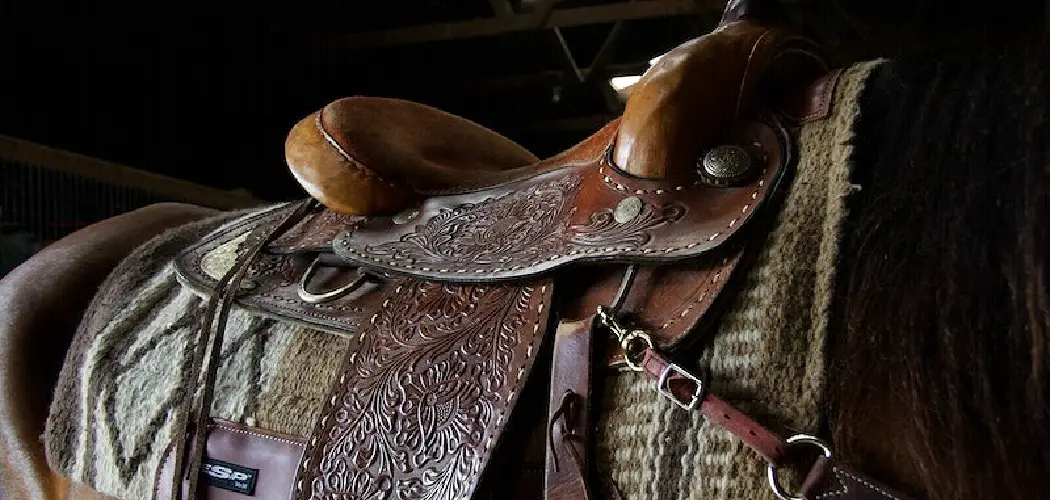Are you looking for the perfect western saddle? Do you know what makes a good western saddle but aren’t sure how to measure it properly? If so, then this blog post is here to help. We’ll walk you through the key steps of measuring a western saddle seat, covering everything from where and how to measure each part of your new purchase.

With our expert advice on fitting your horse correctly with an ideal sized western saddle, you’ll be ready to gallop away happily into equestrian bliss! Thanks for reading this article on how to measure a western saddle seat.
Needed Materials
Given below are the materials that you will need in order to accurately measure your western saddle seat:
- Tape Measure
- Pen and Paper for Note Taking
- A Friend (Optional) For Assistance
11 Step-by-step Guidelines on How to Measure a Western Saddle Seat
Step 1: Prepare the Saddle
The first step is to prepare the saddle by removing any necessary padding and ensuring it is in an upright position. This will make it easier and more accurate to measure the seat. It’s also a good idea to take note of any distinguishing features of the saddle, such as any brand or model numbers. This will help you when searching for a new saddle in the future.
Step 2: Measure the Seat Area
To begin, measure across the widest part of the seat, which is typically near where your legs would sit when mounted on the saddle. This is a key measurement that can influence how comfortable you are while riding with your western saddle. If you don’t feel comfortable with this measurement, then look for a different saddle seat size.
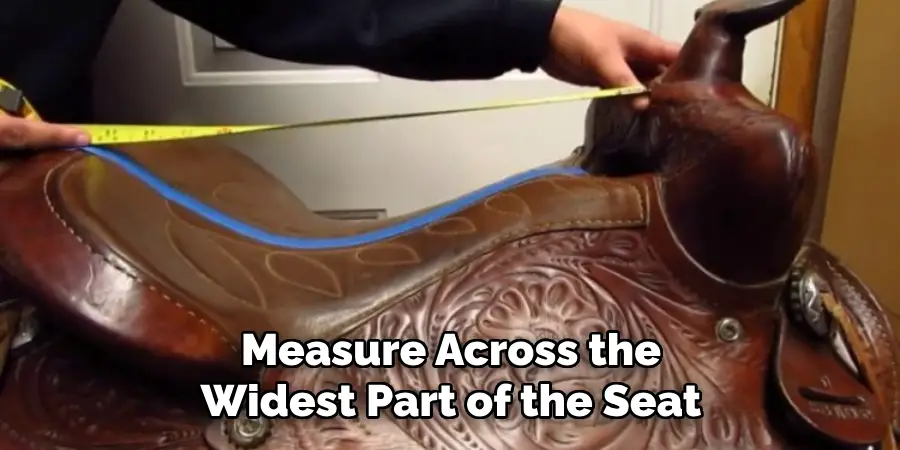
Step 3: Measure the Length
Next, measure the length of the seat. This is done by measuring from the front edge of the seat to where it meets with the cantle in a straight line. Note that this measurement does not include any padding or skirts that may be attached to the saddle. But be sure to measure the full length of the seat in order to get an accurate measurement.
Step 4: Measure the Seat Depth
Now measure the depth of the seat. This is done by placing a tape measure at the front edge of the seat and measuring in a straight line to where your legs would sit when mounted on the saddle. Again, this measurement does not include any padding or skirts that may be attached to the saddle.
Step 5: Measure the Cantle Height
The next measurement to take is the cantle height. To measure this, place a tape measure on the top of the seat and extend it in a straight line up to where it meets with the cantle. This can help you understand how much support your legs will receive when riding in your western saddle.
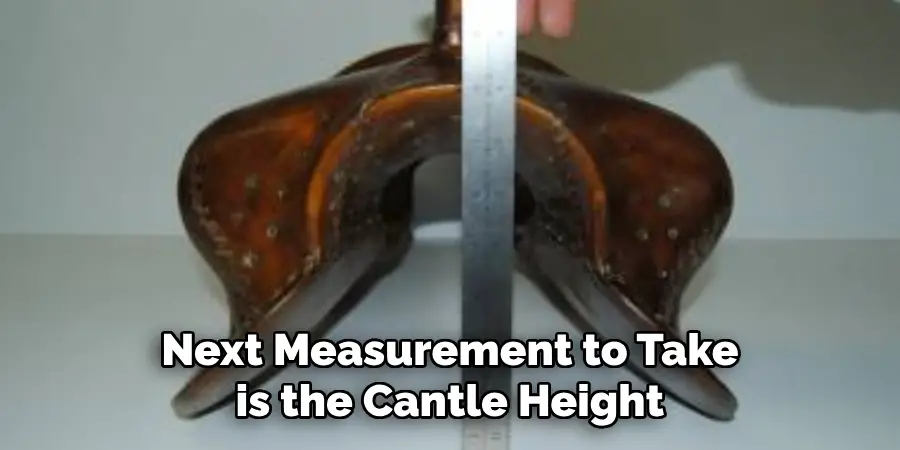
Step 6: Measure the Tree’s Width
The tree width is an important measurement that will determine how much wither clearance your horse has in the saddle. To measure it, start by measuring at the point of your horse’s withers and then extend a tape measure across to where it meets with the other side of the saddle tree.
Step 7: Measure the Gullet Height
The gullet height is another important measurement that will determine how much wither clearance your horse has in the saddle. To measure it, start by measuring from the point of the withers and then extend a tape measure up to where it meets with the top of the swells. It’s important to take this measurement carefully to ensure you have enough wither clearance for your horse.
Step 8: Measure the Flap Length
The flap length is the measurement from where your knee would rest when mounted on the saddle to the very bottom of the stirrup leather. This can help you understand how much leg support you will receive while riding in your western saddle. Otherwise, you may find your legs slipping out from under the saddle as you ride.
Step 9: Measure the Flap Width
To measure the flap width, start by measuring at the point of your knee and then extend a tape measure across to where it meets with the other side of the flap. This will help you determine whether or not your legs are supported correctly when mounted on the saddle. This measurement should be taken carefully to ensure you have enough support and comfort.
Step 10: Measure the Twist
The twist is an important measurement that will determine how balanced your saddle is. To measure it, start by measuring the distance between your thigh and the pommel. Then, measure the same distance from your thigh to the cantle. If both measurements are equal, then your saddle is considered balanced.
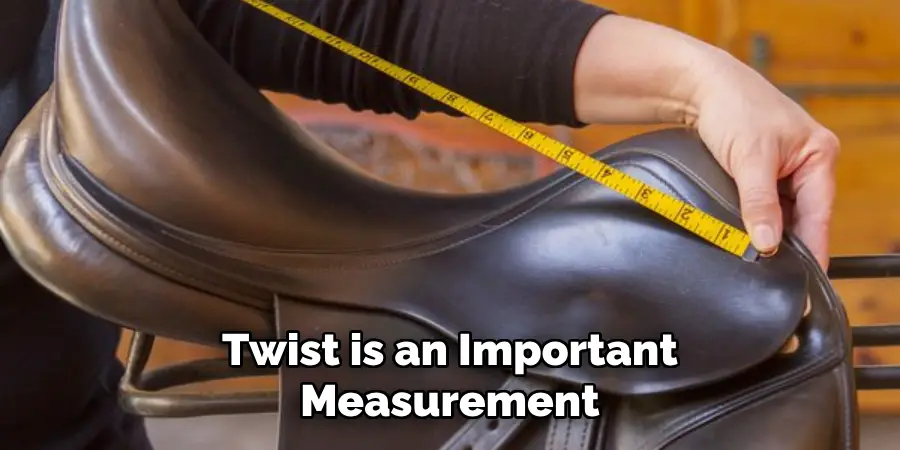
Step 11: Measure Your Horse’s Back Length
Finally, you’ll want to measure your horse’s back length in order to ensure that your saddle fits him correctly. This is done by measuring from the point of your horse’s withers to where his back ends at the point of his croup. Always make sure that your saddle is long enough for his back length or else it can cause discomfort while riding.
Now that you know how to measure a western saddle seat, you can confidently choose one that will fit both you and your horse perfectly! We hope this blog post has helped you learn the correct way to measure a saddle seat and find the perfect fit for your horse. Good luck!
Following up on your western saddle measurements, it is also important to look at the tree shape and bars of the saddle. The tree shape refers to the design of the structure that supports both you and your horse while riding, while bars are used to provide additional support for your horse’s back.
It is essential that these features are considered when selecting a western saddle in order to ensure that it properly fits both you and your horse. In addition, be sure to carefully inspect all the straps and buckles of your saddle before using it for riding. This will help make sure they are in good condition and provide a secure fit.
Frequently Asked Questions
Q: How Often Should I Check the Measurement of My Saddle?
A: We recommend measuring your saddle at least once per year, or more often if you notice any changes in the fit of your saddle. This ensures that it is always properly fitted to you and your horse for maximum comfort and performance while riding.
Q: What Is the Difference Between a Traditional and Western Saddle?
A: The main difference between traditional and Western saddles is in their design. Traditional saddles are designed to be lightweight and comfortable, while Western saddles are designed to provide extra cushioning and support for long rides on tough terrain. Additionally, western saddles usually feature longer flaps and higher cantle heights than traditional saddles.
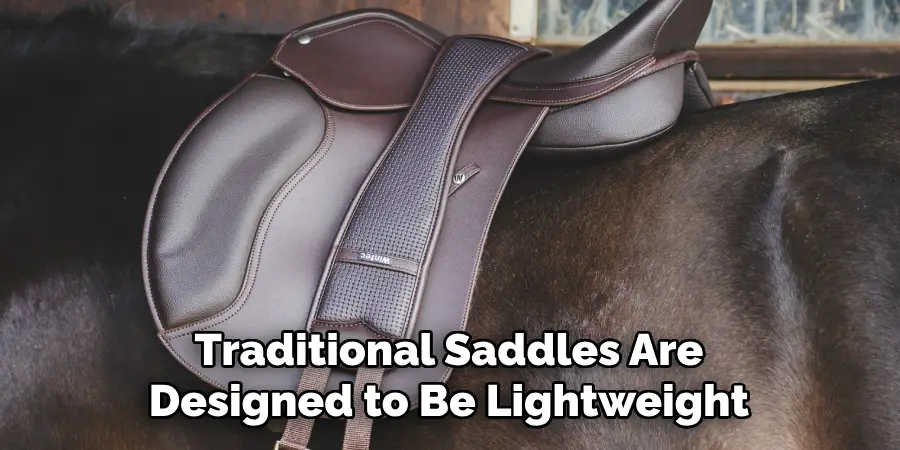
Q: Should I Use a Back Cinch with My Western Saddle?
A: Yes, using a back cinch is highly recommended when riding in a western saddle. The purpose of the back cinch is to provide extra support for your horse’s back and give you more control when riding. Be sure to use the correct size and tension for your horse’s body type in order to ensure optimal comfort and performance.
Q: What Are Some Tips for Choosing the Right Western Saddle?
A: When choosing a western saddle, consider the following tips:
- Make Sure to Measure Your Horse’s Back to Ensure That the Tree of the Saddle is Not Too Wide or Too Narrow.
- Choose a Saddle With Enough Cushioning and Support for Your Horse’s Back.
- Make Sure That the Stirrup Leather is Properly Adjusted to Fit Your Leg Length.
- Ensure That All Straps and Buckles Are in Good Condition and Secure.
- Consider Adding a Back Cinch for Extra Support and Control When Riding.
- The Seat Should Be Comfortable for Both You and Your Horse While Riding.
Conclusion
Measuring a saddle seat correctly is an essential part of selecting the perfect saddle for you and your horse. Not only do proper measurements ensure the correct fit of the saddle, it gives you a better idea of which type of style would work best for your particular riding discipline.
The most important two things to remember when measuring a western saddle seat are to measure accurately and to keep open communication with your saddler or manufacturer.
Lastly on how to measure a western saddle seat, keep in mind that even if the measurements you took are correct, the fit may still be off due to individual characteristics between horses and riders.
By taking certain precautions such as trying multiple saddles with different gullet options or padding systems before making a final decision, it’s possible to find a saddle that fits both you and your horse comfortably. With the right knowledge and careful consideration, riders can find their perfect fitting western saddle!

